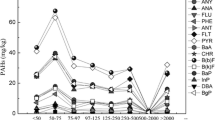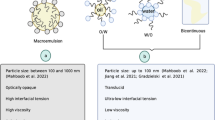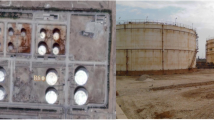Abstract
The surfactant-based microemulsion technique enhances oil-contaminated soil remediation with high removal performance. With the presence of soil in the surfactant–oil–water (SOW) system, surfactants are the key success for this technology due to their activity. This study aimed to investigate the oil removal efficiency of different surfactant mixtures and determine surfactants’ and oil’s material balances in the soil flushing process. The mixed surfactant systems of SDHS-C12-14Ej (j = ethylene oxide group; 1, 5, 9) and SDHS-C16-18E6P4 mixtures were formulated, and a commercial diesel was selected as a model oil. The soil flushing experiment was conducted through the sand pack column with a 0.5 ml/min flow rate at room temperature. It was found that the SDHS-C12-14E1 system (9:1 ratio, 8%wt/v NaCl, Winsor Type III) showed the highest removal efficiency. The intermediate structure (i.e., ethylene oxide: EO) in the SDHS and C12-14Ej is an influent parameter in the surfactant selection for soil remediation. The less EO group in the surfactants, the better sand was decontaminated. The microemulsion types (i.e., I, II, and III) also affected the soil washing/flushing performance. Winsor Type III had the highest oil removal efficiency, followed by Winsor Type I, and II microemulsions. For mass balance in mixed surfactant systems, > 50% of SDHS, an anionic surfactant, remained in the aqueous effluent, while most of C12-14Ej and C16-18E6P4, a nonionic surfactant, solubilized in the oil phase and significantly adsorbed onto the sand.







Similar content being viewed by others
Data availability
All experimental results and data analysis are available from the corresponding authors.
References
Abbas AH, Sulaiman WRW, Jaafar MZ, Aja AA (2017) Anionic surfactant adsorption: insight for enhanced oil recovery. Recent Adv Petrochem Sci 1(5):0082–0085
Abbas AH, Pourafshary P, Sulaiman WRW, Jaafar MZ, Nyakuma BB (2021) Toward reducing surfactant adsorption on clay minerals by lignin for enhanced oil recovery application. ACS Omega 6:18651–18662
Bera A, Kumar T, Ojha K, Mandal A (2013) Adsorption of surfactants on sand surface in enhanced oil recovery: isotherms, kinetics and thermodynamic studies. Appl Surf Sci 284:87–99
Chang Z, Chen X, Peng Y (2018) The adsorption behavior of surfactants on mineral surfaces in the presence of electrolytes—a critical review. Miner Eng 121:66–76
Do LD, Withayyapayanon A, Harwell JH, Sabatini DA (2009) Environmentally friendly vegetable oil microemulsions using extended surfactants and linkers. J Surfact Deterg 12:91–99
Fabbri D, Prevot AB, Zelano V, Ginepro M (2008) Removal and degradation of aromatic compounds from a highly polluted site by coupling soil washing with photocatalysis. Chemosphere 71:59–65
Fan C, Wei Y, Yang Y, Zhang Y (2008) Study on Cu2+ adsorption in magnified continuous-upflow reactor by Saccharomyces cerevisiae and industrial wastewater treatment. IEEE. p 3523–3526
Ghosh J, Tick GR (2013) A pore scale investigation of crude oil distribution and removal from homogeneous porous media during surfactant-induced remediation. J Contam Hydrol 155:20–30
Haleyur N, Shahsavari E, Mansur AA, Koshlaf E, Morrison PD, Osborn AM, Ball AS (2016) Comparison of rapid solvent extraction systems for the GC-MS/MS characterization of polycyclic aromatic hydrocarbons in aged, contaminated soil. MethodsX 3:364–370
He ZQ, Zhang MJ, Fang Y, Jin GY, Chen J (2014) Extended surfactants: a well-designed spacer to improve interfacial performance through a gradual polarity transition. Colloids Surf, A Physicochem Eng Asp 450:83–92. https://doi.org/10.1016/j.colsurfa.2014.03.012
Huang Z, Chen Q, Yao Y, Chen Z, Zhou J (2021) Micro-bubbles enhanced removal of diesel oil from the contaminated soil in washing/flushing with surfactant and additives. J Environ Manag 290:112570
Ishiguro M, Koopal LK (2016) Surfactant adsorption to soil components and soils. Adv Colloid Interface Sci 231:59–102
ITOPF, International Tanker Owners Pollution Federation (2020) Oil tanker spill statistics 2019. Special edition 50 years of data 1970–2019
Jiao Y, Han D, Lu Y, Rong Y, Fang L, Liu Y, Han R (2017) Characterization of pine-sawdust pyrolytic char activated by phosphoric acid through microwave irradiation and adsorption property toward CDNB in batch mode. Desalin Water Treat 77:247–255
Khalladia R, Benhabiles O, Bentahara F, Moulai-Mostefa N (2009) Surfactant remediation of diesel fuel polluted soil. J Hazard Mater 164:1179–1184
Kittithammavong V, Charoensaeng A, Khaodhiar S (2020) Effect of ethylene oxide (EO) group in the anionic-nonionic mixed surfactant system on microemulsion phase behavior. J Surfact Deterg. https://doi.org/10.1002/jsde.12475
Kittithammavong V, Charoensaeng A, Khaodhiar S (2021) A normalized hld (hldn) tool for optimal salt-concentration prediction of microemulsions. Appl Sci 11:9151
Kostic M, Sankaramadhi VK, Simham KC (2006) New educational lab: Measurement and uncertainty evaluation of nanofluid particle concentration using volumetric flask method. American Society for Engineering Education, Illinois-Indiana and North Central Joint Section Conference
Kumar AK, Ghosh P (2022) Recovery of an anionic surfactant in the presence of benzene, toluene, and hexane by foam fractionation. IJEST 19:12345–12356
Lee DH, Chang HW, Cody RD (2004) Synergism effect of mixed surfactant solutions in remediation of soil contaminated with PCE. Geosci J 8(3):319–323
Lee M, Kang H, Do W (2005) Application of nonionic surfactant-enhanced in situ flushing to a diesel contaminated site. Water Res 39:139–146
Lee K, Boufadel M, Chen B, Foght J, Hodson P, Swanson S, Venosa A (2015) The behaviour and environmental impacts of crude oil released into aqueous environments. Canadian Electronic Library, Ottawa, Ontario
Li G, Guo S, Hu J (2016) The influence of clay minerals and surfactants on hydrocarbon removal during the washing of petroleum-contaminated soil. Chem Eng J 286:191–197
Liang T, Hou JR, Qu M, Xi JX, Raj I (2022) Application of nanomaterial for enhanced oil recovery. Pet Sci 19:882–899
Liu JW, Wei KH, Xu SW, Cui J, Ma J, Xiao XL, Xi BD, He XS (2020) Surfactant-enhanced remediation of oil-contaminated soil and groundwater: a review. Sci Total Environ 756:144142
Lv C, Chen J, Wang, X (2017) Evaluation of surfactant performance in in situ foam flushing for remediation of dichlorodiphenyltrichloroethane-contaminated soil. Int J Environ Sci Technol 14:631–638
Mao X, Jiang R, Xiao W, Yu J (2015) Use of surfactants for the remediation of contaminated soils: a review. J Hazard Mater 285:419–435
Muhandiki VS, Shimizu Y, Adou YAF, Matsui S (2008) Removal of hydrophobic micro-organic pollutants from municipal wastewater treatment plant effluents by sorption onto synthetic polymer adsorbents: upflow column experiments. Environ Technol 29:351–361
Newell CJ, Acree SD, Ross RR, Huling SG (1995) Light nonaqueous phase liquids. Ground water issue. USEPA, Washington
Paria S (2008) Surfactant-enhanced remediation of organic contaminated soil and water. Adv Colloid Interface Sci 138:24–58
Perazzo A, Preziosi V, Guio S (2015) Phase inversion emulsification: current understanding and applications. Adv Colloid Interface Sci 222:581–599
Phan TT, Attaphong C, Sabatini DA (2011) Effect of Extended surfactant structure on interfacial tension and microemulsion formation with triglycerides. J Am Oil Chem Soc 88:1223–1228. https://doi.org/10.1007/s11746-011-1784-1
Ramsburg CA, Baniahmad P, Muller KA, Robinson AD (2023) Emulsion-based recovery of a ulticomponent petroleum hydrocarbon NAPL using nonionic surfactant formulations. J Contam Hydrol 255:104144
Rao P, He M (2006) Adsorption of anionic and nonionic surfactant mixtures from synthetic detergents on soils. Chemosphere 63:1214–1221
Rattanaudom P, Shiau BJ, Suriyapraphadilok U, Charoensaeng A (2021) Effect of pH on silica nanoparticle-stabilized foam for enhanced oil recovery using carboxylate-based extended surfactants. J Pet Sci Eng 196:107729
Rodriguez MDF, Gomez MCG, Blazquez NA, Tarazona JV (2014) Soil pollution remediation. Encyclopedia of toxicology. Elsevier, The Netherlands
Rosen MJ (2004) Surfactants and interfacial phenomena, 3rd edn. John Wiley & Sons Inc, USA
Sabatini DA, Knox RC, Harwell JH, Wu B (2000) Integrated design of surfactant enhanced DNAPL remediation: efficient supersolubilization and gradient systems. J Contam Hydrol 45:99–121
Sakhaei Z, Riazi M (2022) In-situ petroleum hydrocarbons contaminated soils remediation by polymer enhanced surfactant flushing: mechanistic investigation. Process Saf Environ Prot 161:758–770
Salager JL, Antón RE (1983) Physico-chemical characterization of a surfactant a quick and precise method. J Dispers Sci Technol 4(3):253–273
Salager RE, Antónand JL (1990) Effect of the electrolyte anion on the salinity contribution to optimum formulation of anionic surfactant microemulsions. J Colloid Interface Sci 140(1):75–81
Shi Z, Chen J, Liu J, Wang N, Sun Z, Wang Z (2015) Anionic–nonionic mixed-surfactant-enhanced remediation of PAH-contaminated soil. Environ Sci Pollut Res 22:12769–12774
Shiau BJB, Brammer JM, Sabatini DA, Harwell JH, Knox RC (2003) Recent development of low concentration surfactant flushing for napl-impacted site remediation and pollution prevention. In: National ground water association, 20th conference and exposition. p 92–106
Tien TH, Bettahar M, Kumagai S (2000) Optimization of the surfactant/alcohol formations for the remediation of oily contaminated porous media. Environ Sci Technol 34:3977–3981
Vreysen S, Maes A (2005) Remediation of a diesel contaminated, sandy-loam soil using low concentrated surfactant solutions. J Soils Sediments 5:240–244
Wang Z, Yang Z, Hu R, Chen YF (2023) Mass transfer during surfactant-enhanced DNAPL remediation: pore-scale experiments and new correlation. J Hydrol 621:129586
Yang K, Zhu L, Xing B (2006) Enhanced soil washing of phenanthrene by mixed solutions of TX100 and SDBS. Environ Sci Technol 40:4274–4280
Yu H, Zhu L, Zhou W (2007) Enhanced desorption and biodegradation of phenanthrene in soil–water systems with the presence of anionic–nonionic mixed surfactants. J Hazard Mater 142:354–361
Zhang B, Matchinski EJ, Chen B, Ye X, Jing L, Lee K (2019) Chapter 12: marine oil spills—oil pollution, sources and effects. World seas: an environmental evaluation. Academic Press, Cambridge, pp 391–406
Zhou W, Zhu L (2004) Solubilization of pyrene by anionic-nonionic mixed surfactants. J Hazard Mater B109:213–220
Zhou W, Zhu L (2008) Enhanced soil flushing of phenanthrene by anionic-nonionic mixed surfactant. Water Res 42:101–108
Zhou X, Liang JT, Andersen CD, Cai J, Lin YY (2018) Enhanced adsorption of anionic surfactants on negatively charged quartz sand grains treated with cationic polyelectrolyte complex nanoparticles. Colloids Surf, A Physicochem Eng Asp 553:397–405
Acknowledgements
The authors thank Hazardous Substance Management and Department of Environmental Engineering, Chulalongkorn University, Thailand, for the support of financing and experimental equipment.
Funding
This work was funded by Chulalongkorn University.
Author information
Authors and Affiliations
Contributions
All authors contributed the idea and concept for this study. The laboratory work, data processing, and first draft manuscript were performed by VK. Revision and editing were performed by AC and SK to approve the final version.
Corresponding author
Ethics declarations
Conflict of interest
We declare that we have no conflicts of interest.
Ethical approval
Not applicable.
Consent to participate
Not applicable.
Consent for publication
Not applicable.
Additional information
Editorial responsibility: Ta Yeong Wu.
Rights and permissions
Springer Nature or its licensor (e.g. a society or other partner) holds exclusive rights to this article under a publishing agreement with the author(s) or other rightsholder(s); author self-archiving of the accepted manuscript version of this article is solely governed by the terms of such publishing agreement and applicable law.
About this article
Cite this article
Kittithammavong, V., Charoensaeng, A. & Khaodhiar, S. Decontamination of oil-contaminated sand using anionic–nonionic mixed surfactant-based microemulsion formation: the study of surfactant and oil balances. Int. J. Environ. Sci. Technol. 21, 5395–5410 (2024). https://doi.org/10.1007/s13762-023-05372-z
Received:
Revised:
Accepted:
Published:
Issue Date:
DOI: https://doi.org/10.1007/s13762-023-05372-z




